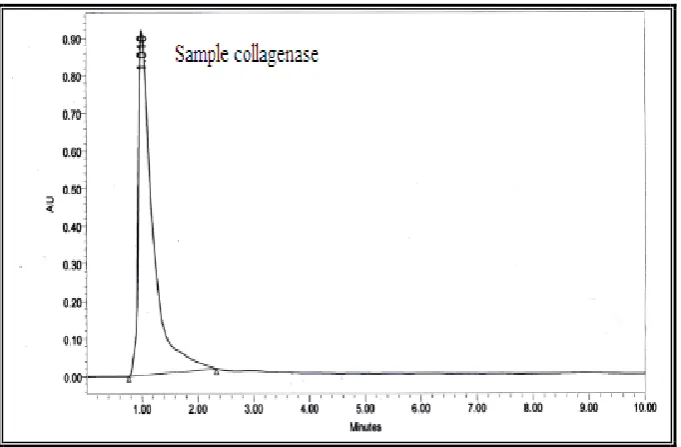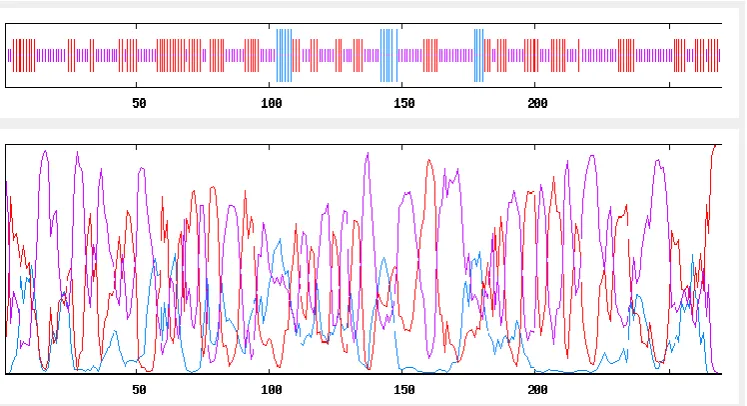Shoba et al. World Journal of Pharmaceutical and Life Sciences
BIOCHEMICAL ANALYSIS AND HOMOLOGY MODELING OF
COLLAGENASE PROTEIN OF SCYLLA SERRATA CRAB
Shoba K.1*, S. Sowmiya2 andDr. Mazher Sultana3
1
Assistant Professor in Biochemistry, Department of Biochemistry, DKM College, Vellore.
2
M.Phil, Research Scholar, Biotechnology Department, DKM College for Women, Vellore.
3
Departments of Advanced Zoology and Biotechnology, Presidency College, Chennai.
Article Received on 26/12/2016 Article Revised on 15/01/2017 Article Accepted on 06/02/2017
ABSTRACT
Scylla serrata (often called mud crab or mangrove crab, although both terms are highly ambiguous, as well as black crab) is an economically important species of crab found in the estuaries and mangroves of Africa, Australia and Asia. In their most common form, the shell colour varies from a deep, mottled green to very dark brown. The enzyme collagenase is extracted from Uca pugilator and it is estimated by using Lowry’s method. Collagenase is biochemically analysed with SDS-PAGE and HPLC. The activity of the enzyme is assayed and characterized by determining the optimum pH and temperature. The effect of activator and inhibitor on collagenase activity is obtained. To analyse the primary sequence and to predict the homology modeling of collagenase protein in Sylla serrata using bioinformatics tools Like Prot param, Swiss model server. The modeled 3D structure of the peptide clearly shows the potential antigen binding sites which would be useful in structure based drug designing studies in future.
KEYWORDS:Scylla serrata, SDS –PAGE, HPLC, Prot Param, Swiss Model Server.
INTRODUCTION
Scylla serrata inhabits muddy bottoms, mangrove marshes and river mouths in estuarine environments. It is native to the Indo-Pacific and has been introduced to Florida, Hawaii and elsewhere, most often intentionally in attempts to establish populations of this commercially important species.
World Journal of Pharmaceutical and Life Sciences
WJPLS
www.wjpls.org SJIF Impact Factor: 4.223
Scylla serrata from Karwar, India. Interest in the aquaculture of this species has been high due to the high demand/price for them, high flesh content and rapid growth rates in captivity. In addition, they have a high tolerance to both nitrateand ammonia (twice that of the similar sized Portunus pelagicus), which is beneficial because ammonia-N is often the most limiting factor on closed aquaculture systems. Their high ammonia-N tolerance may be attributed to various unique physiological responses which may have arisen due to their habitat preferences.
Studies indicate Scylla serrata become reproductively mature starting at around 90 mm carapace width, often within the first year of life (Robertson and Kruger 1994, Knuckey 1996).
Male crabs approach female crabs before the femeles have undergone a precopulatory molt, grasping them with their chelipeds and first pair of walking legs and carrying them around for up to several days until the females molt. On molting, males turn the females over and initiate copulation, delivering non-motile spermatozoa that may be retained by the females for up to several weeks to months before being used to fertilize multiple clutches of up to 2 million eggs each (Chen 1976). Hill (1996) notes that females bearing egg masses on their pleopods migrate offshore where the eggs hatch in a few weeks.
Enzymes are proteins that catalyze (i.e., increase or decrease the rates of) chemical reactions. In enzymatic reactions, the molecules at the beginning of the process are called substrates, and they are converted into different molecules, called the products. Almost all processes in a biological cell need enzymes to occur at significant rates. Since enzymes are selective for their substrates and speed up only a few reactions from among many possibilities, the set of enzymes made in a cell determines which metabolic pathways occur in that cell.
few RNA molecules called ribozymes also catalyze reactions, with an important example being some parts of the ribosome. Synthetic molecules called artificial enzymes also display enzyme-like catalysis.
Enzyme activity can be affected by other molecules. Inhibitors are molecules that decrease enzyme activity; activators are molecules that increase activity. Many drugs and poisons are enzyme inhibitors. Activity is also affected by temperature, chemical environment (e.g., pH), and the concentration of substrate. Some enzymes are used commercially, for example, in the synthesis of antibiotics. In addition, some household products use enzymes to speed up biochemical reactions (e.g., enzymes in biological washing powders break down protein or fat stains on clothes; enzymes in meat tenderizers break down proteins into smaller molecules, making the meat easier to chew).
In 1959, the first commercially available collagenase isolated from Clostridium histolyticum was offered by Worthington. At that time, only one preparation of crude enzyme was offered. Collagenases are endopeptidases that digest native collagen in the triple helix region. Collagens are the major fibrous component of animal extracellular connective tissue. Bacterial collagenases differ from vertebrate collagenases in that they exhibit broader substrate specificity (Peterkofsky 1982, Birkedal-Hansen 1987).
METHODS
Using bioinformatics tools protein sequence was analyzed using PROTPARM tool and the secondary structure was predicated using GOR IV tool to identify the various structural regions present in the protein sequence. Finally the collagenase protein was modeled through swiss model server and validated using rapper server.
RESULTS
As with all forms of gel electrophoresis, molecules may be run in their native state, preserving the molecules' higher-order structure or a chemical denaturant may be added to remove this structure and turn the molecule into an unstructured linear chain whose mobility depends only on its length and mass-to-charge ratio. In most proteins, the binding of SDS to the polypeptide chain imparts an even distribution of charge per unit mass, thereby result ing in a fractionation by approximate size during electrophoresis. The result of SDS-PAGE is shown in Fig 1.
Lane: 1 Protein Marler (66, 000, 43, 000, 29, 000, 14,000Da) Lane: 2 Crude enzymes
Lane: 3 Supernatant obtained from centrifugation.
Lane: 4 Extract obtained from Ion exchange chromatography Lane: (5-7) Extract obtained from after analysis
Fig 2: HPLC chromatogram of standard collagenase.
BIOINFORMATICS
Using bioinformatics tools protein sequence was analyzed using PROTPARM tool and the secondary structure was predicated using GOR IV tool to identify the various structural regions present in the protein sequence. Finally the collagenase protein was modeled through swiss model server and validated using rapper server.
Protein sequence retrieval system
>AAC47030.1 serine collagenase 1 precursor [Scylla serrata]
MIVKLALILVCVALASGNPAAGTEWRWKSPKPLMTPIGPVKSSRIVGGVEAVPNSWP HQAALFIDDMYFC
GGSLISPEWILTAAHCMDGAGFVDVVLGAHNIREDEATQVTIQSTDFTVHENYNSFVI SNDIAVIRLPSP
VTLTAAIATVGLPSTDVGVGTVVTPTGWGLPSDSALGISDVLRQVDVPIMSNADCDA VYGIVTDGNICID
STGGKGTCNGDSGGPLNYNGLTYGITSFGAAAGCEAGYPDAFTRVTYFLDWIQTQT GITP
Fasta format sequence of collagenase protein.
Fig 4: Blue – Helix, Red – sheets and Blue –Coils regions of the Collagenase protein sequence.
Homology modeling
The modelled protein 3D strucure were viewed with the help of advanced molecular viusalization software called discovery studio .Inorder to identyfy the structural region and classify the entire 3d structural elements.
Fig 5: The above picture represents the ribbon and cartoon, space fill Model of collagenase protein.
CONCLUSION
Collagenase is selective to necrotic tissue but is not harmful to clean tissue when applied to the wound bed. It may be applied directly to the wound bed, or if the tissue is slick, it may be easier to apply to the dressing. This collagenase would be very useful for medicine, food industry and leather scrap recycles.
The primary aim of the present bioinformatics work is to analyze the complete molecular protein profiling and secondary structure prediction of the (Scylla serrata) collagenase protein sequence. Based on the results of primary and secondary structure prediction, the results show physiochemical Properties (Mw, pI, molecular weight, total number of Atoms etc,). The results of secondary structure show the Total percentage of helix, sheets and coils present in the collagenase protein sequence. From the results of homology studies and evaluation of collagenase shows the Number of residues in favoured region 93.2%. All the above results will be useful for pharmacology and Pharmacogenomics studies.
REFERENCES
1. Antonio Buitragoc, Erik Gylfec, Christen Henrikssonand Håkan Pertoft Department of Surgery, Sahlgren's Hospital, University of Göteborg, S-413 45, Göteborg, Sweden Department of Medical and Physiological Chemistry, The Biomedical Center, Box 571, S-751 23, Uppsala, Sweden Department of Histology, The Biomedical Center, Box 571, S-751 23, Uppsala, Sweden Received 17 October 1977. Available online 26 October 2004.
2. Augusto Serafini-Fracassini, J. Michael Fielda, Graham W. Rodgera and Michele Spina*, a Bode, W., Gomis-Ruth, F.X., Huber, R., Zwilling, R. & Stacker, W. Structure of asatcin and implications for activation of astacins and zinc-ligation of collagenase. Nature, 1992; 358: 164−167.
3. Department of Biochemistry, University of St. Andrews, St. Andrews U.K. Received 6 January 1975.
4. Department of Biochemistry, University of St. Andrews, St. Andrews U.K. Received 26 August 1974. Available online 27 January 2003.
5. Department of Chemistry, Pukyong National University, Busan 608-737, Korea.
6. Department of Food Science and Engineering, Cheju National University, Cheju 690-756, Korea.
8. Facultad de Ciencias, Universidad Nacional Autónoma de México, Apdo, Postal 21-630, Coyoacan, Mexico DF 04000: Unidad Xochimilco, Universidad Autónoma Metropolitana, Mexico; and Instituto Nacional de Enfermedades Respiratorias, Mexico. 9. Gross, J., Harper, E., Harris, E.D. Jr., McCroskery, P.A., Highberger, J.H., Corbett, C.
and Kang, A.H.: Biochem. Biophys. Res. Comm., 1974; 61: 605. 10.Hamlin, C.R., Kohn, R.R. and Luschin, J.H.: Diabetes, 1975; 24: 902. 11.Harris, E.D., Jr. and Farrell, M.E.: Biochem. Biophys. Acta, 1972; 278: 133.
12.Harris, E.D., Jr. and Krane, S.M.: New Eng. J. Med., 1974; 291, 557, 605, 652. in mussel. J Cell Sci, 113: 2759–2769.
13.Istituto di Istologia ed Embriologia, Università di Padova, Padova Italy J WOCN Volume 36/Number S6 Ramundo & Gray S9 WON200095.qxp 10/29/09 9:46 PM Page 9 S10 Ramundo & Gray J WOCN November/December 2000.
14.J. Limona, P. Dal Cina and A.A. Sandberg J. Limona, P. Dal Cina and A.A. Sandberg Roswell Park Memorial Institute, Buffalo, NY USA Received 4 November 1985; accepted 18 December 1985. Available online 6 February 2003.
15.Jiravanichpaisal P, Lee BK, Soderhall K. Cell-mediated immunity in arthropods: hematopoiesis, coagulation, melanization and opsonization. Immunobiology, 2006; 211: 213–236.
16.Kurtz J. Specific memory within innate immune systems. Trends Immunol, 2005; 26: 186–192.
17.Lee SY, Soderhall K. Early events in crustacean innate immunity. Fish Shellfish Immunol, 2002; 12: 421–437.
18.Lehrer RI, Ganz T. Antimicrobial peptides in mammalian and insect host defense. Curr Opin Immunol, 1999;11: 23–27.
19.Luis F. Jiménez-García, Julia Pérez-Ramos, Moisés Selman and Annie Pardo M. Spinaa, G. Garbina, J.M. Fieldb and A. Serafini-Fracassinib Mandl, I., Keller, S. and Manahan, J.: Biochem., 1964; 3: 1737.
20.Mandl, I., MacLennan, J.D., Howes, E.L., DeBellis, R.H. and Sohler, A.: J. Clin. Invest, 1953; 32: 1323.
21.Mitta G, Vandenbulcke F, Noel T, Romestand B, Beauvillain JC, Salzet M, Roch P (2000) Differential distribution and defense involvement of antimicrobial peptides Moore, S. and Stein, W.H.: J. Biol. Chem., 1948; 176: 367.
23.Pyo-Jam Park, Sang-Hoon Lee, Hee-Guk Byun, Soo-Hyun Kim† and Se-Kwon Kim* Received 26 July 2002, Accepted 10 September 2002.
24.Roche Products Ltd, P.O Box 8, Welwyn Garden City, Hertfordshire, AL7 3AY, UK Roswell Park Memorial Institute, Buffalo, NY USA Received 4 November.
25.Seifter, S. and Harper, E.: in Methods in Enzymology XIX, (Perlmann, G.E. and Lorand, L.: Eds), pg. 613, Academic Press, Seifter, S. and Harper, E.: in The Enzymes III, (Boyer, P.D., Ed.), pg. 649, Academic Press, New York, 1971.
26.Stedman's Medical Spellchecker, © 2006 Lippincott Williams & Wilkins Tissue Culture, Methods and Applications, (Kruse, P.F. and Patterson, M.K.: Eds.), pg. 16-20, Academic Press, New York, 1972.
27.Wild, Paul W. and Robert N. Tasto (eds.) Life history, environment and mariculture studies of the Dungeness crab, Cancer magister, with emphasis on the central California fishery resource, 1983.
28.Wooley, E.E., Lindberg, K.A., Glanville, R.W. and Evanson, J.M.: Eur. J. Biochem., 1975; 50: 437.


